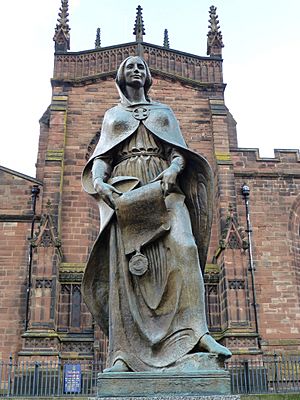Wulfrun facts for kids
Quick facts for kids
Wulfrun
|
|
|---|---|

Charles Wheeler's statue of Lady Wulfrun at St Peter's Church, Wolverhampton
|
|
| Born | c. 935 |
| Died | c. 1005 (aged roughly 70) |
| Burial place | possibly Tamworth |
| Other names | Wulfruna |
| Occupation | Landowner, noblewoman |
| Years active | before 990s-1005 |
| Known for | The person who endowed St Peter's Collegiate Church and having a close connection to the founding of the city of Wolverhampton |
| Children | 2 sons (Wulfric Spot & Ælfhelm of York) |
Wulfrun (born around 935, died around 1005) was an important noblewoman and landowner. She lived in Mercia, an ancient kingdom in England, about 1,000 years ago. She owned land in a region now known as Staffordshire.
Today, Wulfrun is especially remembered for her connection to a place called Hēatūn. This old English name meant "high farm" or "main enclosure." In 985, King Æthelred II (also known as Æthelred the Unready) gave this land to Wulfrun. In 994, she founded a church there. By 1070, this place became known as Wolvrenehamptonia. This name means "Wulfrun's high farm." Today, we know it as the city of Wolverhampton, a large city in the West Midlands of England.
Who Was Wulfrun?
Early Life and Family
Wulfrun was born around the year 935 in Mercia. She had strong ties to Tamworth. At that time, Tamworth was a very important center of royal power in Mercia.
According to an old record called the Anglo-Saxon Chronicle, Wulfrun was taken by Danes from Tamworth in 943. Later, her son Wulfric Spot left land in Tamworth to his daughter. This land was to be "not subject to any service nor to any man born." Wulfric may have inherited this land from Wulfrun. It is also believed that Wulfrun was buried with the religious community in Tamworth. Wulfric also left land to this community.
Wulfrun's Important Children
Wulfrun had two known sons who became very powerful. Her son Wulfric "Spot" became one of King Æthelred's main thegns (a type of noble or lord) in the 990s. He owned even more land than his mother. By the time he died around 1002-1004, he had land in many parts of England. These areas included Derbyshire, Warwickshire, and Northumbria. In his will, which still exists today, he gave much of his land to help rebuild Burton Abbey.
Her other son, Ælfhelm, became an ealdorman (a high-ranking royal official) of Northumbria. He held this important position from about 994 until his death in 1006. Ælfhelm's daughter, Ælfgifu, married Cnut. Cnut later became the King of England. This marriage happened after Cnut's father, Sweyn Forkbeard, invaded England in 1013. Ælfgifu later played a key role in helping her son, Harold Harefoot, become king in 1036.
Wulfrun also had at least one other child, a daughter. Wulfric's will mentions gifts to the daughter of his sister, Ælfthryth. This suggests that Ælfthryth had passed away before Wulfric wrote his will in 1002.
Her Death and Legacy
We do not know Wulfrun's exact death date. However, a document from 1005, related to Eynsham Monastery, mentions her. It says Wulfrun gave land at Ramsey while she was "at her last breath." This means she likely died shortly after this document was written, sometime in 1005.
Wulfrun's lands may have been passed down from Wulfsige the Black. King Edmund gave Wulfsige lands in 942. Some of these lands match those Wulfrun later gave away. Others match lands mentioned in her son Wulfric's will. This suggests that Wulfsige may have been Wulfrun's father.
Wulfrun's actions, especially founding the church in Hēatūn, were very important. Her legacy lives on in the name of the city of Wolverhampton.

